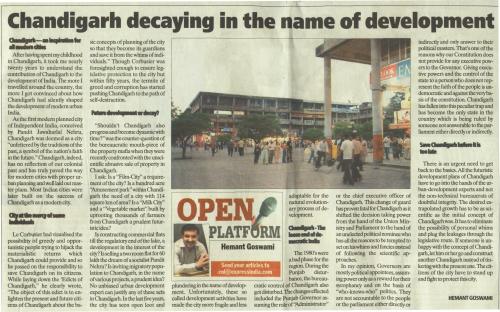Whosoever said that “The road to hell is paved with bricks of good intention,” knew how the masses can be manipulated into thinking that they will benefit if a particular idea is executed. Metro for Chandigarh is just another example of misleading and manipulating the common people for gains other than public welfare.
The first thing that goes into planning of MRTS (Mass Rapid Transport System) is to understand the extent of congestion, the existing walkability within the city and an appreciation of the fact, as to whether the capacity of the surface transport has been exhausted to its limits. Interestingly, according to the ‘Ministry of Urban Development’ official report, Chandigarh has zero (0) congestion index, which is the least in the country. Chandigarh also has the highest walkability index of 0.91 in the entire country. We have still not exhausted our surface transport options. The “City Bus Transport Supply Index (CBTSI)” for Chandigarh is just 17.54, which is quite low for organised cities of this size. For example, the CBTSI for Trivandrum is 20, Madurai is 42.7, Hyderabad is 31, Chennai is 39, Delhi is 43, Kolkata is 26. A mere perusal of this data shows that there is no requirement for Metro or Monorail in Chandigarh.
Global studies and experience has shown that Metro is a desirable option only for high density corridors and with long trip length of an average of more than 14Km. In Chandigarh the average journey time using private mode of transport is between 5 minutes to 17.5 minutes. This reflects that the majority of the trips generated in the city are short trips in the order of 2.5 to 9.6 km in length. In Chandigarh nearly 71 percent of the motor vehicle is two-wheelers. Around 83 percent of all trips are those work trips which are accessible in 15 minutes time. Clearly Metro is not a feasible option on this count too.
Another thing to be considered for feasibility of Metro is the “Per Hour Peak Direction Trips (PHPDT),” which is the average number of people in any particular area (corridor) travelling during the peak traffic time. While rejecting the proposal of Metro for Chandigarh, the eleven membered committee set up by the Central Government to asses an appropriate MRTS for the region mentioned that, “Whatever be the merits of a conventional metro system, whether below or above the ground or on the surface, such a mode is justified only when the demand is 60-70,000 PHPDT.” In case of Chandigarh the maximum traffic demand estimated by the year 2041 is 30,000 PHPDT, which does not justify spending public money on Metro. Even the Metro expert E. Sreedharan has rejected the option of Metro for Chadnigarh.
The cost of constructing and running Metro too must be considered. Even if part financing comes from the central government, still Chandigarh will have to spend over a couple of thousand Crores for the construction alone. One of the options given by the officials (and the 2009 RITES report) is that, “Funds are proposed to be retained through property development, i.e. sale of Commercial plots in Chandigarh, the property/ plots earmarked for this purpose may be transferred by the Chandigarh Administration.” This is sure way to disaster. Not only will this disturb the entire planning of Chandigarh but it will then bring in disastrous chaos as a result of the new commercial plots put for sale for constructing Metro. The miseries will not end here, besides the initial development cost of Rs. 150 crores per km. there would be a prohibitive recurring cost of running the Metro, which means, that the public has to bear the losses from year-to-year even if the average trip cost is kept at Rs. 50 compared to Rs. 10 for a bus-ride.
Instead of wasting thousands of Crores on Metro, Chandigarh must use a bus based rapid transport system which is capable of carrying 30,000 PHPDT very comfortably. (See the table) Most of the chaos created in Chandigarh is mainly because of not following the Master Plan made by Le Corbusier, disturbing the sanctity of ‘Chandigarh’s periphery’ shifting of the bus-stand and plying the buses irrationally. If viable, rational, reliable, effective and fast bus transport system is given to the people of Chandigarh, it would be easily able to meet the cities need for another 40 years.
Many bureaucrats are proposing Metro for Chandigarh just because they see good money and spill-over coming to them through sale of land, showrooms and contracts executed in the name of Metro. Bureaucrats, who are spending public money on reports and consultants to push the idea for Metro in Chandigarh after two successive committees of the Central Government have said that Metro for Chandigarh is not feasible, are wasting public resources besides cheating the public.
Hemant Goswami



 While scanning the expenses of the Governor of Punjab, we found large scale wastage of resources through the office of the Governor’s. The office operates more-or-less without any accountability, supervision and responsibility. A large number of staff personnel, not required otherwise, have been appointed to take care of the Governor.
While scanning the expenses of the Governor of Punjab, we found large scale wastage of resources through the office of the Governor’s. The office operates more-or-less without any accountability, supervision and responsibility. A large number of staff personnel, not required otherwise, have been appointed to take care of the Governor.